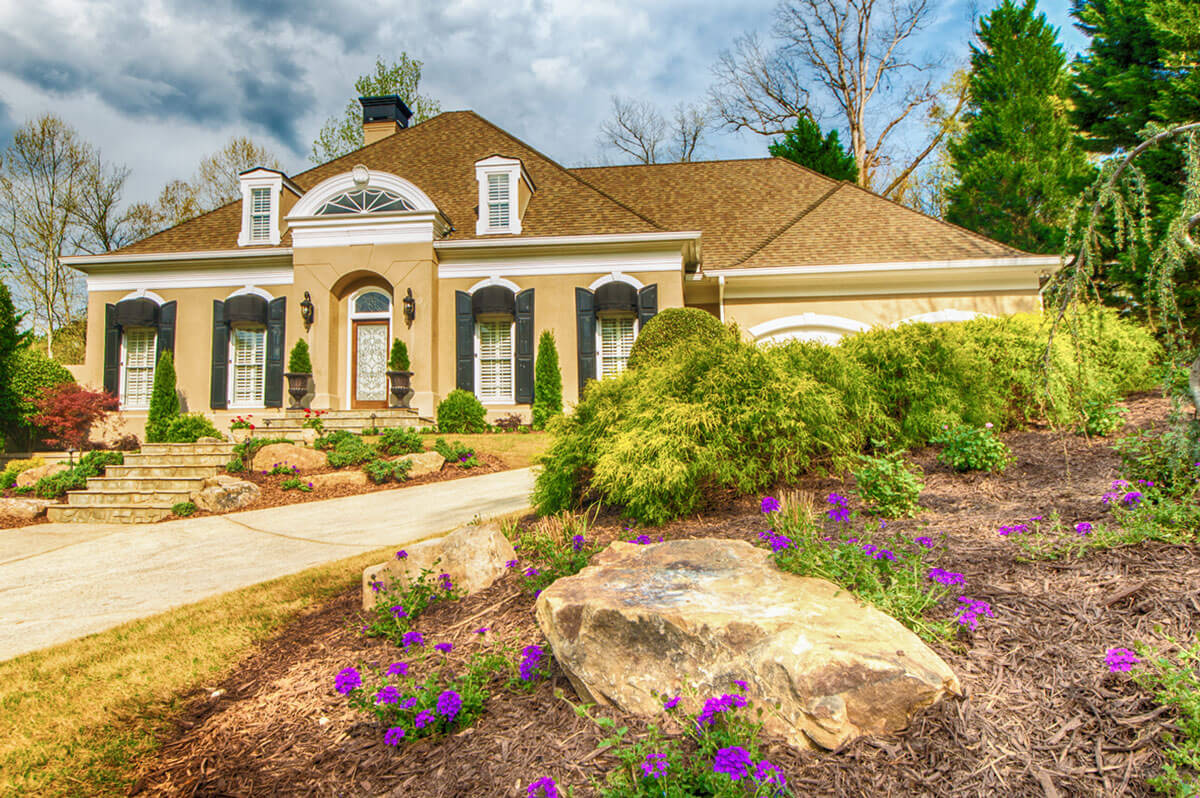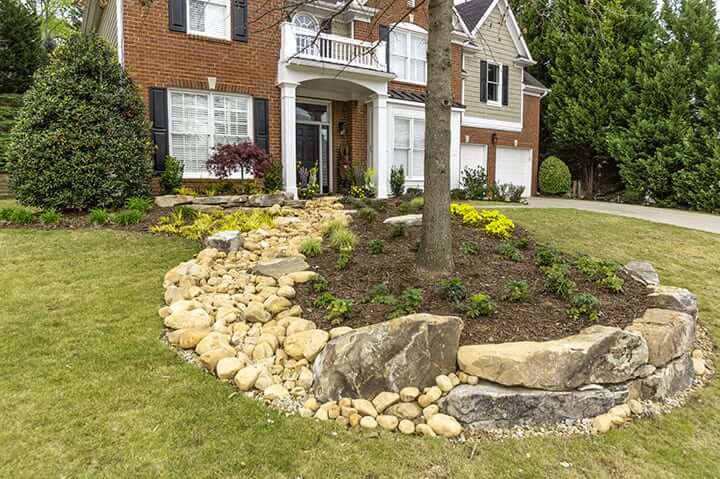Hardscaping is a component of landscaping that gives outdoor spaces structure and utility. Hardscape landscaping entails imaginative, artificial layouts for our outdoor area. Building retaining walls, laying foundations, and planting trees are all components of landscape design. Your front yard, backyard and the appearance of your home are both enhanced when you add something to your outdoor environment.
All of the non-living components that make up the landscape are referred to as hardscape. The hardscape harmonizes with the softscape to produce aesthetics that would otherwise be impossible with just the softscape. Concrete, bricks, stone, or wood are a few examples of hardscape materials; these elements make up your landscape’s hardscape. Lawn hardscaping goes beyond mere aesthetics, much like urban hardscaping. Lets learn further about hardscape and softcape in our post below:
Hardscaping & Softscaping: The Perfect Landscaping Duo
Hardscape Landscaping
- Hardscaping examples include walkways and bridges. Bridges and walkways are man-made.
- Effective hardscaping examples include fire pits. They make excellent substitutes for grills or fires.
- Set Hardscaping includes the use of stones. Although natural, stones are not alive. The moss is considered softscaping if it covers the stone.
- Hardscape components include arches above pathways. They can be added to fences or gardens.
- Even when vines are growing on them, they are a straightforward and adaptable style of construction that might be regarded as hardscaping
Softscape Landscaping
- Because they are living things, trees are regarded as softscaping. But, softscaping includes even trees that you plant yourself.
- There is life in plants. The plants themselves are still softscaping elements even when they grow on walls or other hardscaping elements.
- Because they are alive, hedges are living in softscaping. Hedge walls are considered softscaping, whereas any other kind of retaining wall is considered hardscaping./li>
- Berms are dirt mounds that can be categorized as hardscaping, but because they are used to grow plants, they are only hardscaping when they are finished. Hence, this combines many forms of landscaping.
Hardscaping and Landscaping: What is the Difference?
Every landscape design is composed of a combination of softscaping elements, which are any plants like flowers or trees, and hardscaping elements, which include walkways, gravel roads, fountains, and structural accents. Although inanimate, hardscaping frequently serves as the framework for softscaping, which develops and changes over time.
The structures used in landscaping that are composed of non-living materials are referred to as hardscaping. It’s critical to understand the distinction between landscaping and hardscaping if you’re seeking for landscaping and hardscaping services.
Hardscaping: The use of hard materials to design a practical place is known as hardscaping. This can entail adding hardscape components (think: sidewalks, patios, stairs). Professional hardscapers deal with concrete materials rather than dirt and plants in their line of work. It may also refer to landscaping that uses artificial materials, such as gravel or concrete, in place of organic elements like plants.
Landscaping: Using plants, flowers, and other natural elements to design a location is known as landscaping. Any home or business development project must include landscaping. By improving the curb appeal of houses and other structures, landscaping can be used to raise property values.
Types of Hardscaping:
Hardscaping refers to the non-living components of a landscape design, including features such as paths, walls, patios, and outdoor structures. Here are some common types of hardscaping:
- Fire pits: A built-in outdoor fireplace or fire pit made of brick or stone is a useful hardscaping element that can improve the use and ambiance of your outdoor space.
- Paths and Walkways: These can be made from various materials such as natural stone, pavers, or gravel, and can be used to create a defined route through a garden or outdoor space
- Retaining Walls: These are used to hold back soil and create level areas in a garden or outdoor space. They can be made from a variety of materials including concrete, stone, and timber.
- Patios and Decks: These are outdoor living areas that are typically paved or decked, providing a space for seating, dining, and entertaining. Materials used for patios and decks include brick, natural stone, pavers, and timber.
- Outdoor structures: These include gazebos, pergolas, and trellises. They are often used to create a focal point in a garden, as well as to provide shade and privacy.
- Water features: These include fountains, ponds, and waterfalls. They are a popular addition to outdoor spaces and can be used to create a calming and relaxing atmosphere.
- Statues: These are decorative elements that can be used to add interest and personality to a garden. They can be made from a variety of materials including stone, metal, and ceramics.
- Gazebos and pergolas: Hardscaping includes freestanding buildings that can be placed in your outdoor living area. Examples include gazebos and pergolas, which can be used to create walkways that are partially covered. They make your outdoor space more livable and offer shade and shelter for outdoor gatherings.
Benefits of Adding Hardscape Landscaping to Outdoor Space
Adding hardscape landscaping adds both functionality and beauty to your home. Check out some of the specific benefits of hardscaping below.
- Fix grade problems: Having an uneven lawn may lead to many issues such as soil erosion and inaccessible sections. A retaining wall can be added to assist stop soil erosion and make a level area for plants to thrive in. A steep slope can be made easier to access by building a path or some stairs. A sloped or uneven portion of your lawn might be smoothed out by a patio.
- Add Privacy: Your entire yard can become a private area by adding a fence or a stone wall. Nevertheless, if you prefer the way your yard flows into the yard of your neighbor, you can build a gazebo or pergola to create a private space. If you’re planning to extend your outdoor living space, make the most of our landscape architecture services in Georgia that fits your specific residential requirements.
- Expand Your Living Space: Many house owners envision having an outdoor kitchen, bar, and fire pit where they can host friends and family while barbecuing outside in the summer. This is made feasible by hardscaping, which produces sturdy, durable, fireproof, and weatherproof surfaces on which you can mount the required machinery.
Along with producing distinct textures that contrast with the space’s plants and flowers, hardscaping will also provide variety to it. You’ll be able to create focal points thanks to it as well. - Boosts Property Value: Most property owners want to raise the value of their land, and you may do this by adding the appropriate hardscapes. This is due to the fact that it results in an exterior home addition while also gaining usable additional square footage.
About 80% of home buyers prefer a property with them, according to studies, therefore those who plan to sell their houses in the future will impress potential buyers with their hardscape. Hardscapes are highly desirable due to the availability of entertainment space as well as the extra dimensions and erosion resistance.
Factors to consider while choosing hardscape landscaping contractor
The curb appeal of your property can be made or broken by the landscaping you choose to invest in. It’s also a crucial factor to take into account while purchasing a new home. Yet picking a landscaping business is a difficult undertaking. If you’re looking for the best landscape contractor in Georgia, follow these tips to choose your contractor and be sure that your home is in good hands.
- Do your research properly: The curb appeal of your property can be made or broken by the landscaping you choose to invest in. It’s also a crucial factor to take into account while purchasing a new home. Yet picking a landscaping business is a difficult undertaking.
- Check the reputation of the company: Do some background research on potential landscape contractors and look for testimonials about their prior work before contacting them. It can assist you in selecting the ideal contractor for your needs. You can readily check out reviews of any company thanks to Google. If you come across some unfavorable comments about a contractor, look into them further to get the specifics of what went wrong.
- Experience: The level of experience a landscaping business has is one of the most important things to take into account before employing them. Every year, the landscape industry undergoes change, therefore it’s important to choose someone who can keep up with these developments while also staying on top of them. Because of this, you must take the time to investigate and evaluate their knowledge, expertise, and credentials. Do they hold any accolades or achievements from the business world? What specific kind of landscaping do they focus on? How long has the company been in operation?
- Services Offered: The services that a landscaping business provides are a crucial consideration while making your decision. Not all businesses are made equal; some could focus on particular industries while others offer a wider range of services. Do you require assistance with the design and installation of your landscape? Or are you just in need of regular maintenance services? Finding a business that provides the services you require is crucial if you want to avoid working with many contractors on your landscaping job. Long-term, this will save you both time and money. Working with a single business that can handle all of your landscaping needs is also a lot more convenient than having to coordinate with many parties.
- Licensing and insurance: Confirm that the contractor is licensed and insured to operate in your area. Verify the insurance status of the landscape contractor you select. The contractor has most likely undergone some form of formal training if they have a license. Additionally, it implies that any contractor employed is required to abide by federal, state, and local rules and regulations. Employing an uninsured landscape contractor puts you at risk for harm, increases your risk of property damage, and produces less-than-appealing results.
How Outdoor Makeover & Living Spaces is going to help you?
Are you willing to improve the look of your landscape design this season? Investing in your outdoor living space is as crucial as investing in your interiors. Hardscaping not only extends your living space and makes it more inviting, but it also improves the value of your home/property.
Our Hardscaping Installation Services
- Hardscape Design services
- Stone pathways & walkways
- Patios
- Stone & brick retaining walls
- Concrete retaining walls
- Custom outdoor fireplaces
- Concrete pavers
- Native stone pavers
Whether you are looking for hardscape installation services in Decatur or near you in Atlanta,Outdoor Makeover & Living Spaces’ professional landscape designers have the ability to turn any outdoor space into an oasis. Our landscape artists combine landscape design, creativity, functionality, and experience to bring your family the best design possible. Hardscaping features add a clean and polished look to your outdoor living space. From simple patios and walkways to full outdoor kitchens and rooms, we can transform the outdoors into something beautiful that you will want to spend countless hours relaxing in with friends and loved ones.
Schedule a Consultation with us!


 Screened-in Porch Benefits for Outdoor Living Experience
Screened-in Porch Benefits for Outdoor Living Experience Landscape Preparation For Spring
Landscape Preparation For Spring Preparing for Winter: 10 Tips for Winterizing Your Landscape
Preparing for Winter: 10 Tips for Winterizing Your Landscape
LET'S BE SOCIAL: